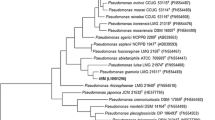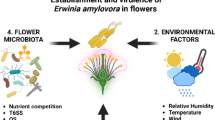Abstract
A survey of all major pome fruit growing regions was conducted during 2005 and 2006 to establish whether Erwinia amylovora, the causal agent of fire blight, was present in Syria. Samples were collected from quince (Cydonia oblonga), pear (Pyrus communis) and apple (Malus domestica) trees suspected of being infected with E. amylovora. Seventy-five isolates of E. amylovora were recovered, mainly from quince and some from pear but none from apple. All isolates produced typical symptoms of fire blight when tested on immature pear fruit. Two isolates were shown to induce a delayed hypersensitivity reaction on tobacco. All the isolates were confirmed to be E. amylovora by PCR using primers specific for this bacterium. One set of primers amplifies a fragment of the native plasmid (pEA29) and a second set amplifies a fragment involved in the synthesis of amylovoran, the structurally unique exopolysaccharide of this bacterium. Fire blight was found to prevail in the Al-Zabadani region (Rif Damascus), an area with a moderate temperature range (10–29°C) and high relative humidity (above 70%) during the blossom period. However, the diseasewas found to be restricted within Syria and observed only in isolated foci near the Lebanese border. This is the first isolation and identification of E. amylovora from Syria
Similar content being viewed by others
References
Al-Dahmashi MS, Khlaif H (2004) Fire blight of pome fruits in Jordan: disease development and response of different fruit cultivars to disease. Scientia Horticulturae 101, 81–93. doi: 10.1016/j.scienta.2003.10.007
Benlioglu K (1988) National research project report on fire blight of pome fruits. Ministry of Agriculture and Rural Affairs, Plant Protection Research Institute, Ankara, Turkey.
Bereswill S, Pahl A, Bellemann P, Zeller W, Geider K (1992) Sensitive and species-specific detection of Erwinia amylovora by polymerase chain reaction analysis. Applied and Environmental Microbiology 58, 3522–3526.
Bereswill S, Bugert P, Bruchmuller I, Geider K (1995) Identification of the fire blight pathogen, Erwinia amylovora, by PCR assays with chromosomal DNA. Applied and Environmental Microbiology 61, 2636–2642.
Billing E, Baker LAE, Cross JE, Garrett CME (1961) Characterization of English isolates of Erwinia amylovora (Burrill). Journal of Applied Bacteriology 24, 195–211.
Bonn WG, Van der Zwet T (2000) Distribution and economic importance of fire blight. In ‘Fire blight — the disease and its causative agent Erwinia amylovora’. (Ed. JL Vanneste) pp. 37–51. (CABI Publishing: Wallingford)
Brennan JM, Doohan FM, Egan D, Scanlan H, Hayes D (2002) Characterization and differentiation of Irish Erwinia amylovora isolates. Journal of Phytopathology 150, 414–422. doi: 10.1046/j.1439-0434.2002.00789.x
Falkenstein H, Zeller W, Geider K (1989) The 29 kb plasmid, common in strains of Erwinia amylovora, modulates development of fire blight symptoms. Journal of General Microbiology 135, 2643–2650.
Ishimaru C, Klos EJ (1984) Newmedium for detection of Erwinia amylovora and its use in epidemiological studies. Phytopathology 74, 1342–1345.
Jock S, Donat V, Lopez MM, Bazzi C, Geider K (2002) Following spread of fire blight in western, central and southern Europe by molecular differentiation of E. amylovora strains with PFGE analysis. Environmental Microbiology 4, 106–114. doi: 10.1046/j.1462-2920.2002.00277.x
King EO, Ward M, Raney DE (1954) Two simple media for the demonstration of pyocyanin and fluorescein. Journal of Laboratory and Clinical Medicine 44, 401–407.
Miller JH (1972) ‘Experiments in molecular genetics.’ (Cold Spring Harbor Laboratory Press: Cold Spring Harbor, NY)
Miller TD, Schroth MN (1972) Monitoring the epiphytic population of Erwinia amylovora on pear with a selective medium. Phytopathology 62, 1175–1182.
Momol MT, Aldwinckle HS (2000) Genetic diversity and host range of Erwinia amylovora. In ‘Fire blight — the disease and its causative agent Erwinia amylovora’. (Ed. JL Vanneste) pp. 55–72. (CABI Publishing: Wallingford)
Psallidas PG, Dimova M (1986) Occcurence of the disease fire blight of pomaceous trees in Cyprus — characteristics of pathogen Erwinia amylovora. Annals of the Institute of Phytopathology 15, 61–70.
Saad AT, Hanna L, Asly OJ, Choueiri E (1999) The distribution and host range of the first serious outbreak of fire blight in Lebanon. Acta Horticulturae 489, 65–69.
Thomson SV (2000) Epidemiology of fire blight? In ‘Fire blight — the disease and its causative agent Erwinia amylovora’. (Ed. JL Vanneste) pp. 9–36. (CABI Publishing: Wallingford)
Van der Zwet T (1993) World widespread and present distribution of fire blight. An update. Acta Horticulturae 338, 29–33.
Van der Zwet T (2002) Present worldwide distribution of fire blight. Acta Horticulturae 590, 33–34.
Vanneste JL (2000) What is fire blight? Who is Erwinia amylovora? How to control it? In ‘Fire blight — the disease and its causative agent Erwinia amylovora’. (Ed. JL Vanneste) pp. 1–5. (CABI Publishing: Wallingford)
Vanneste JL, Eden-Green S (2000) Migration of Erwinia amylovora in host plant tissues. In ‘Fire blight — the disease and its causative agent Erwinia amylovora’. (Ed. JL Vanneste) pp. 73–85. (CABI Publishing: Wallingford)
Zutra D, Shabi E (1985) First evidence of fire blight in Israel. Phytoparasitica 13, 151.
Author information
Authors and Affiliations
Corresponding author
Rights and permissions
About this article
Cite this article
Ammouneh, H., Arabi, M.I.E. & Al-Daoude, A. The first record and distribution of the fire blight pathogen Erwinia amylovora in Syria. Australasian Plant Pathology 37, 137–140 (2008). https://doi.org/10.1071/AP07093
Received:
Accepted:
Issue Date:
DOI: https://doi.org/10.1071/AP07093




